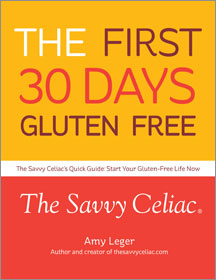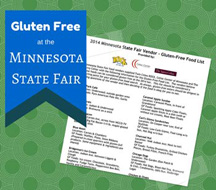Crazy as it sounds…new research published in this month’s Journal of Clinical Gastroenterology and Hepatology says indeed Hydrolyzed Wheat Flour may be okay for celiac patients to consume!
Wouldn’t it be great to cross another ingredient off the “forbidden” list for celiacs? In 10 years, we’ve done it twice. Shortly after Emma was diagnosed 10 years ago, it became official that we could take distilled vinegar off the list (let’s all have a collective “whew” on that one), and then the “okay” of oats came a few short years later. While I’m not exactly endorsing hydrolyzed wheat flour yet (it did take me about 3 years to buy gluten-free oats after they were deemed safe as long as they were certified gluten free), this is a topic that is definitely worth keeping up on.
What is Hydrolyzed Wheat Flour?
Well surprisingly there isn’t a lot of information about this available. During my research I found it is often used in cosmetics. And it is there that I actually found a definition: “Hydrolyzed wheat protein is a natural protein derived from wheat or wheat flour with the starch removed.” Hydrolysis is “A chemical reaction in which the interaction of a compound with water results in the decomposition of that compound,” as defined by Biology.com.
In this study, researchers interchange the terms of fermented wheat flour and hydrolyzed wheat flour. The study explained, “Fermentation of wheat flour with sourdough lactobacilli [bacteria] and fungal proteases [groups of enzymes that hydrolyze (breakdown) peptide bonds of proteins] decreases the concentration of gluten” thus making it more tolerable by celiacs. Researchers set out with their study to prove this.
What Researchers Found that May Help Celiacs
“A 60-day diet of baked goods made from hydrolyzed wheat flour, manufactured with sourdough lactobacilli and fungal proteases, was not toxic to patients with CD.” Journal of Clinical Gastroenterology and Hepatology
A news release promoting this study has made the rounds on the internet, I found it in several places including MedIndia.com. It quoted researchers saying,
“This is the first time that a wheat flour-derived product is shown to not be toxic after being given to celiac patients for 60 days,” said Luigi Greco, MD, PhD, of the University of Napes, Italy, and lead author of the study. “Our findings support further research that explores therapies that could reduce the toxicity of gluten for celiac patients beyond the standard gluten-free diet….
Prolonged trials have to be planned to underscore the safety of baked goods made by applying the rediscovered and adapted biotechnology of hydrolysis. In the future, cereals made through such biotechnology could also improve the nutritional and sensory properties of baked goods containing hydrolyzed gluten compared to products made of naturally gluten-free ingredients.”
So no, you probably shouldn’t go out right now and eat anything with hydrolyzed wheat flour in it. But it is an interesting first step that maybe some day could lead us to cross it off the “unsafe” ingredient off the list.
Update from University of Maryland’s Center for Celiac Research: Statement on their Facebook page: “…the CFCR and Dr. Fasano believe it is too early to make treatment decisions based on this [hydrolyzed wheat flour research]. This is preliminary data and more in-depth studies need to be done. The data is not conclusive.”
Thank you to CFCR for making a statement on this subject.
Tags: celiac, gluten-free, hydrolyzed wheat flour, ingredients, research, study



January 21st, 2011 at 10:47 am
I think there is definitely a lot of hope for something like this to be safe, but I’m wondering if eating hydrolized ANYTHING protein is good for anyone!
January 23rd, 2011 at 9:49 pm
If it wasn’t safe we’d be neck deep in dead infants 😉
Hydrolized proteins are the basis of hypoallergenic elemental formulas-commonly fed to highly atopic babies. Neocate is one brand. Hydrolysis just means the protein is predigested (broken down into its elemental form).
June 6th, 2013 at 12:37 pm
It has been almost 2.5 years now since this study came out and I am surprised Dr. Fasano hasn’t tried to replicate this to see if this works. How hard would that have been? I am getting a bit miffed at the researchers on this and the delays. Any non profit group for an autoimmune condition will be out of business when they crack this gut flora relationship. They all are coming to the same cross roads and it feels like they are all going sloooooow mooooo now.
April 19th, 2014 at 9:51 am
If you do a little research on this, it sounds to me that hydrolyzed wheat is basically sprouted wheat.
As bakers of sprouted grain breads, we’ve known for a long time that sprouting wheat degrades gluten development. If you look on the ingredient lists of large scale sprouted bakers (Alverado street and Ezekial breads) you will find they add gluten into the dough.
We’ve found this is not necessary as long as you’re willing to work with a natural leaven for your starter. Natural leavens were the ONLY way breads were made up until seventy or so years ago when a single fast-acting strand of yeast could be isolated and made stable. This largely enabled large scale bread production – it was fast, cheap and very profitable. Only problem was, it could not neutralize gluten through bacterial fermentation.
Mainly, these things are simple. The industry, as it is wont to do, ignores simple in favor of scalability and profit maximization. And as long as consumers support industrial processes, I don’t care if they are eating gluten free or wheat based products, they are still eating toxic food stuffs.
Doug
columbiacountybread.com